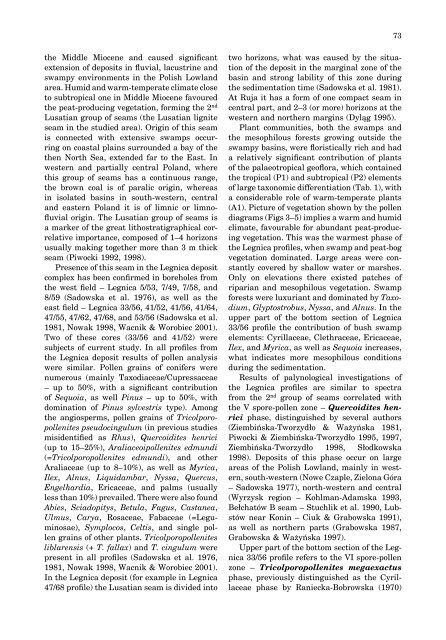Middle Miocene palynoflora of the Legnica lignite deposit complex ...
Middle Miocene palynoflora of the Legnica lignite deposit complex ...
Middle Miocene palynoflora of the Legnica lignite deposit complex ...
Create successful ePaper yourself
Turn your PDF publications into a flip-book with our unique Google optimized e-Paper software.
<strong>the</strong> <strong>Middle</strong> <strong>Miocene</strong> and caused signifi cant<br />
extension <strong>of</strong> <strong>deposit</strong>s in fl uvial, lacustrine and<br />
swampy environments in <strong>the</strong> Polish Lowland<br />
area. Humid and warm-temperate climate close<br />
to subtropical one in <strong>Middle</strong> <strong>Miocene</strong> favoured<br />
<strong>the</strong> peat-producing vegetation, forming <strong>the</strong> 2 nd<br />
Lusatian group <strong>of</strong> seams (<strong>the</strong> Lusatian <strong>lignite</strong><br />
seam in <strong>the</strong> studied area). Origin <strong>of</strong> this seam<br />
is connected with extensive swamps occurring<br />
on coastal plains surrounded a bay <strong>of</strong> <strong>the</strong><br />
<strong>the</strong>n North Sea, extended far to <strong>the</strong> East. In<br />
western and partially central Poland, where<br />
this group <strong>of</strong> seams has a continuous range,<br />
<strong>the</strong> brown coal is <strong>of</strong> paralic origin, whereas<br />
in isolated basins in south-western, central<br />
and eastern Poland it is <strong>of</strong> limnic or limn<strong>of</strong>l<br />
uvial origin. The Lusatian group <strong>of</strong> seams is<br />
a marker <strong>of</strong> <strong>the</strong> great lithostratigraphical correlative<br />
importance, composed <strong>of</strong> 1–4 horizons<br />
usually making toge<strong>the</strong>r more than 3 m thick<br />
seam (Piwocki 1992, 1998).<br />
Presence <strong>of</strong> this seam in <strong>the</strong> <strong>Legnica</strong> <strong>deposit</strong><br />
<strong>complex</strong> has been confi rmed in boreholes from<br />
<strong>the</strong> west fi eld – <strong>Legnica</strong> 5/53, 7/49, 7/58, and<br />
8/59 (Sadowska et al. 1976), as well as <strong>the</strong><br />
east fi eld – <strong>Legnica</strong> 33/56, 41/52, 41/56, 41/64,<br />
47/55, 47/62, 47/68, and 53/56 (Sadowska et al.<br />
1981, Nowak 1998, Wacnik & Worobiec 2001).<br />
Two <strong>of</strong> <strong>the</strong>se cores (33/56 and 41/52) were<br />
subjects <strong>of</strong> current study. In all pr<strong>of</strong>i les from<br />
<strong>the</strong> <strong>Legnica</strong> <strong>deposit</strong> results <strong>of</strong> pollen analysis<br />
were similar. Pollen grains <strong>of</strong> conifers were<br />
numerous (mainly Taxodiaceae/Cupressaceae<br />
– up to 50%, with a signifi cant contribution<br />
<strong>of</strong> Sequoia, as well Pinus – up to 50%, with<br />
domination <strong>of</strong> Pinus sylvestris type). Among<br />
<strong>the</strong> angiosperms, pollen grains <strong>of</strong> Tricolporopollenites<br />
pseudocingulum (in previous studies<br />
misidentifi ed as Rhus), Quercoidites henrici<br />
(up to 15–25%), Araliaceoipollenites edmundi<br />
(=Tricolporopollenites edmundi), and o<strong>the</strong>r<br />
Araliaceae (up to 8–10%), as well as Myrica,<br />
Ilex, Alnus, Liquidambar, Nyssa, Quercus,<br />
Engelhardia, Ericaceae, and palms (usually<br />
less than 10%) prevailed. There were also found<br />
Abies, Sciadopitys, Betula, Fagus, Castanea,<br />
Ulmus, Carya, Rosaceae, Fabaceae (=Leguminosae),<br />
Symplocos, Celtis, and single pollen<br />
grains <strong>of</strong> o<strong>the</strong>r plants. Tricolporopollenites<br />
liblarensis (+ T. fallax) and T. cingulum were<br />
present in all pr<strong>of</strong>i les (Sadowska et al. 1976,<br />
1981, Nowak 1998, Wacnik & Worobiec 2001).<br />
In <strong>the</strong> <strong>Legnica</strong> <strong>deposit</strong> (for example in <strong>Legnica</strong><br />
47/68 pr<strong>of</strong>i le) <strong>the</strong> Lusatian seam is divided into<br />
73<br />
two horizons, what was caused by <strong>the</strong> situation<br />
<strong>of</strong> <strong>the</strong> <strong>deposit</strong> in <strong>the</strong> marginal zone <strong>of</strong> <strong>the</strong><br />
basin and strong lability <strong>of</strong> this zone during<br />
<strong>the</strong> sedimentation time (Sadowska et al. 1981).<br />
At Ruja it has a form <strong>of</strong> one compact seam in<br />
central part, and 2–3 (or more) horizons at <strong>the</strong><br />
western and nor<strong>the</strong>rn margins (Dyląg 1995).<br />
Plant communities, both <strong>the</strong> swamps and<br />
<strong>the</strong> mesophilous forests growing outside <strong>the</strong><br />
swampy basins, were fl oristically rich and had<br />
a relatively signifi cant contribution <strong>of</strong> plants<br />
<strong>of</strong> <strong>the</strong> palaeotropical ge<strong>of</strong>l ora, which contained<br />
<strong>the</strong> tropical (P1) and subtropical (P2) elements<br />
<strong>of</strong> large taxonomic differentiation (Tab. 1), with<br />
a considerable role <strong>of</strong> warm-temperate plants<br />
(A1). Picture <strong>of</strong> vegetation shown by <strong>the</strong> pollen<br />
diagrams (Figs 3–5) implies a warm and humid<br />
climate, favourable for abundant peat-producing<br />
vegetation. This was <strong>the</strong> warmest phase <strong>of</strong><br />
<strong>the</strong> <strong>Legnica</strong> pr<strong>of</strong>i les, when swamp and peat-bog<br />
vegetation dominated. Large areas were constantly<br />
covered by shallow water or marshes.<br />
Only on elevations <strong>the</strong>re existed patches <strong>of</strong><br />
riparian and mesophilous vegetation. Swamp<br />
forests were luxuriant and dominated by Taxodium,<br />
Glyptostrobus, Nyssa, and Alnus. In <strong>the</strong><br />
upper part <strong>of</strong> <strong>the</strong> bottom section <strong>of</strong> <strong>Legnica</strong><br />
33/56 pr<strong>of</strong>i le <strong>the</strong> contribution <strong>of</strong> bush swamp<br />
elements: Cyrillaceae, Clethraceae, Ericaceae,<br />
Ilex, and Myrica, as well as Sequoia increases,<br />
what indicates more mesophilous conditions<br />
during <strong>the</strong> sedimentation.<br />
Results <strong>of</strong> palynological investigations <strong>of</strong><br />
<strong>the</strong> <strong>Legnica</strong> pr<strong>of</strong>i les are similar to spectra<br />
from <strong>the</strong> 2 nd group <strong>of</strong> seams correlated with<br />
<strong>the</strong> V spore-pollen zone – Quercoidites henrici<br />
phase, distinguished by several authors<br />
(Ziembińska-Tworzydło & Ważyńska 1981,<br />
Piwocki & Ziembińska-Tworzydło 1995, 1997,<br />
Ziembińska-Tworzydło 1998, Słodkowska<br />
1998). Deposits <strong>of</strong> this phase occur on large<br />
areas <strong>of</strong> <strong>the</strong> Polish Lowland, mainly in western,<br />
south-western (Nowe Czaple, Zielona Góra<br />
– Sadowska 1977), north-western and central<br />
(Wyrzysk region – Kohlman-Adamska 1993,<br />
Bełchatów B seam – Stuchlik et al. 1990, Lubstów<br />
near Konin – Ciuk & Grabowska 1991),<br />
as well as nor<strong>the</strong>rn parts (Grabowska 1987,<br />
Grabowska & Ważyńska 1997).<br />
Upper part <strong>of</strong> <strong>the</strong> bottom section <strong>of</strong> <strong>the</strong> <strong>Legnica</strong><br />
33/56 pr<strong>of</strong>i le refers to <strong>the</strong> VI spore-pollen<br />
zone – Tricolporopollenites megaexactus<br />
phase, previously distinguished as <strong>the</strong> Cyrillaceae<br />
phase by Raniecka-Bobrowska (1970)

















